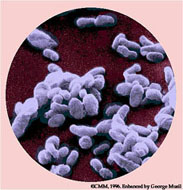




Prokaryotes
Two of the major domains of life are prokaryotes
bacteria and archaea.
The prokaryotic cell has a cell wall, surrounding cytoplasm,
but there is no nucleus. The DNA
is concentrated in certain areas of the cell and is called a nucleoid.
Some prokaryotes have an extra outer layer which is slimy and helps protect
it from drying out or being digested. When a cell divides,
the DNA replicates and the two strands move into the new cells, without
the "spindle apparatus" that is present in eukaryote
cells. Overall the prokaryote cell is much simpler than the eukaryote,
although it is chemically very similar.


Typical prokaryotes (left) and a typical eukaryote
(right)
Eukayotes
The
domain of the Eukaryotes includes a large variety of living organisms
from algae, fungi
and protists to plants and animals.

Eukaryotic means the cell has a nucleus. Every cell is made up of a cell wall, which is a thin plasma membrane surrounding cytoplasm, which in turn surrounds the nucleus. Outside the nucleus a eukaryotic cell has several complex and vital subunits. Two of these, mitochondria and (in plant cells only) chloroplasts or plastids, have their own DNA. They enable the cell to respire and photosynthesize, respectively. Plant cells have extra layers of cellulose around the plasma membrane which give the cells a more rigid structure, but they are linked to neighboring cells through small pores. In both cases the nucleus contains the hereditary DNA instruction information for the cell, while the cytoplasm contains the energy storage and is where the cell's activities take place. Eukaryotic cells produce a structure known as a "spindle", upon which the chromosomes (containing the DNA) arrange themselves before dividing in the cell division process "mitosis". Eukaryote cells usually have a pair of copies of the genome.
There is good evidence to support the idea that mitochondria and chloroplasts are no more than bacteria in their own right, which invaded other cells. This would normally be classed as infection - that is the invaded cell becomes "ill" and dies - but in this case the host and invader have developed a "working relationship" or symbiosis whereby they help each other to survive and flourish. In the case of the development of eukaryote cells the relationship has remained for around 2 billion years and is present in all this domain of organisms, including ourselves.
Which
came first?
It is thought that prokaryotes appeared on Earth before eukaryotes, as
their cell structure is simpler. The little fossil evidence that
exists also supports this. Once they had evolved, it appears that
eukaryotes were able to evolve further much more quickly than prokaryotes.
Life seems to have been on Earth for about 3.85 billion years and during
the first half of this only prokaryotes apparently existed.
Go
to
Home
| Space Station
| Mars | Rainforest
© 1999 Satellite Events Enterprises Inc.